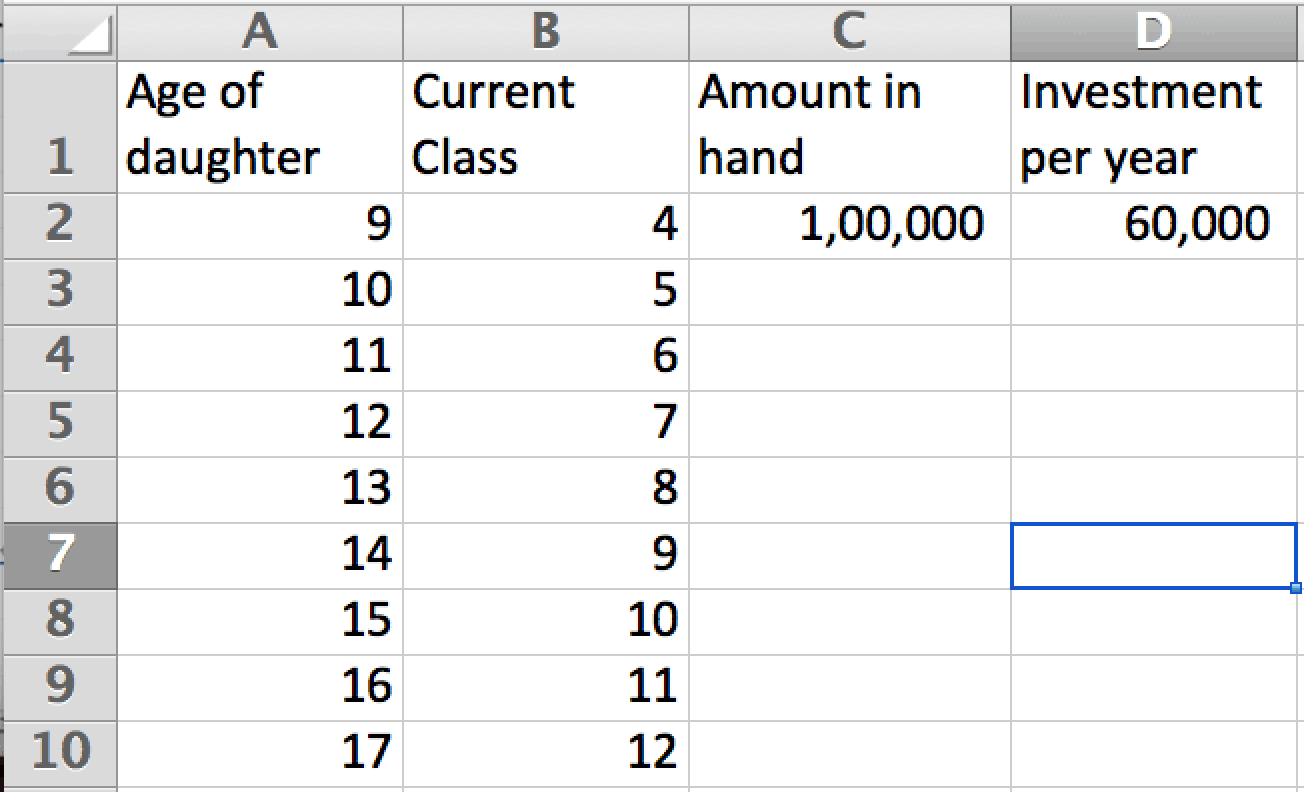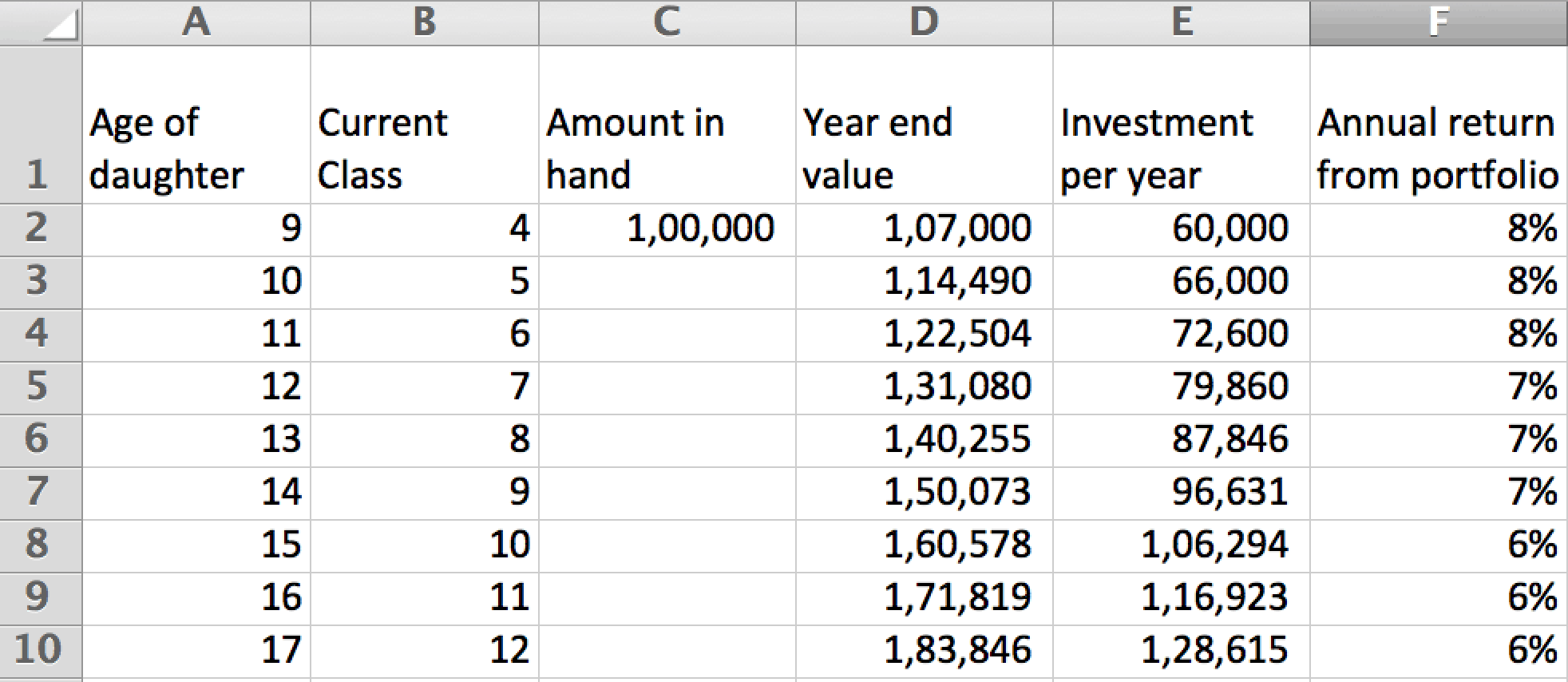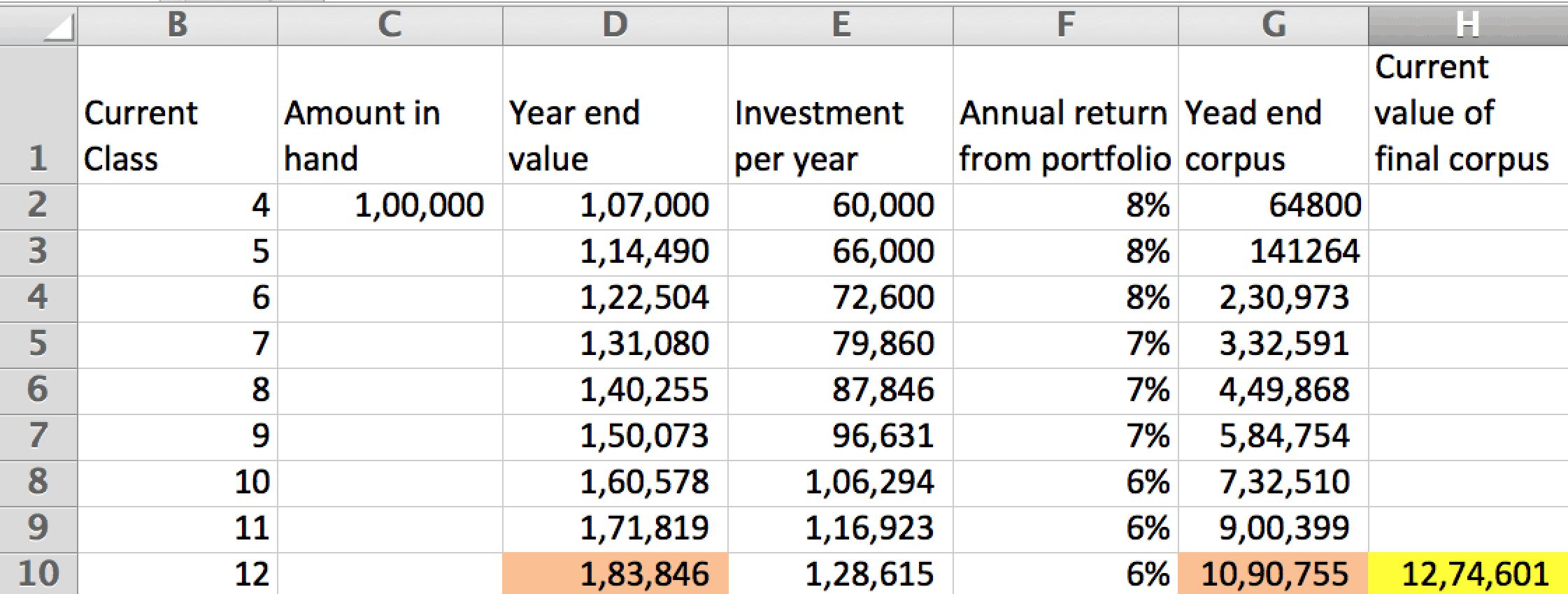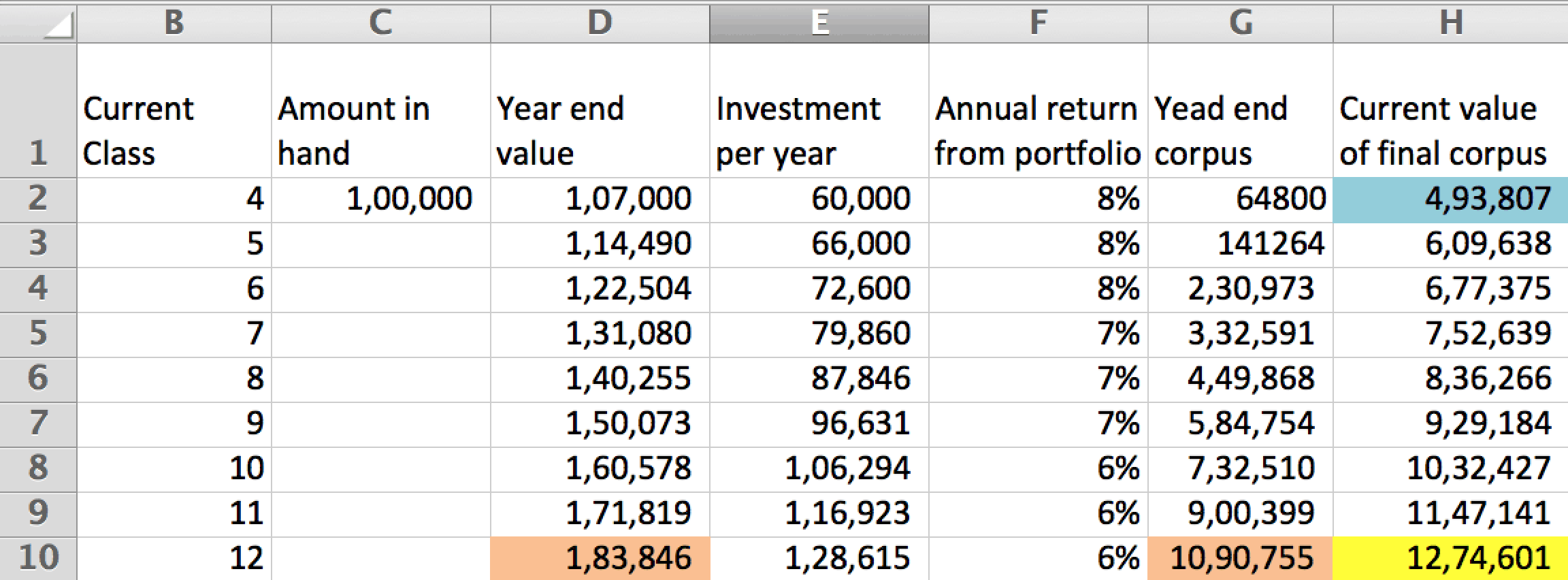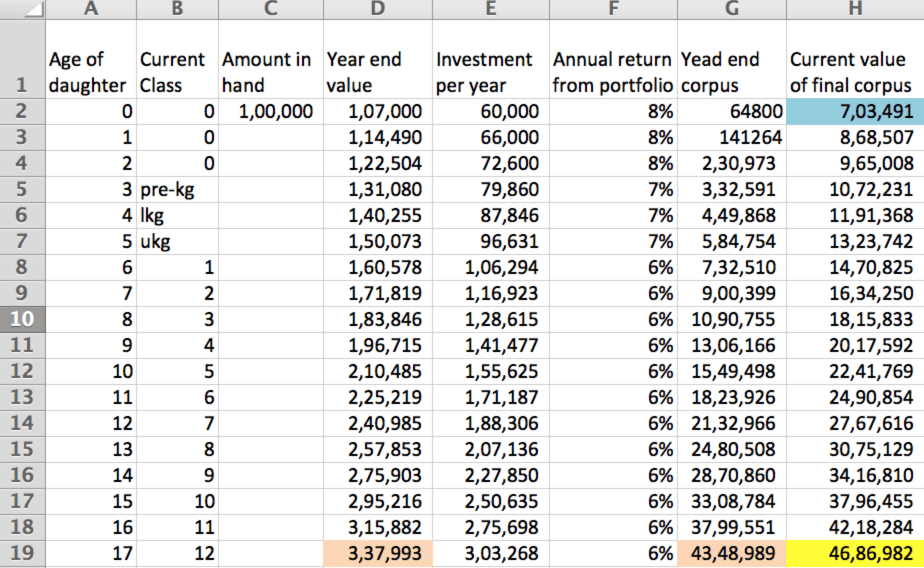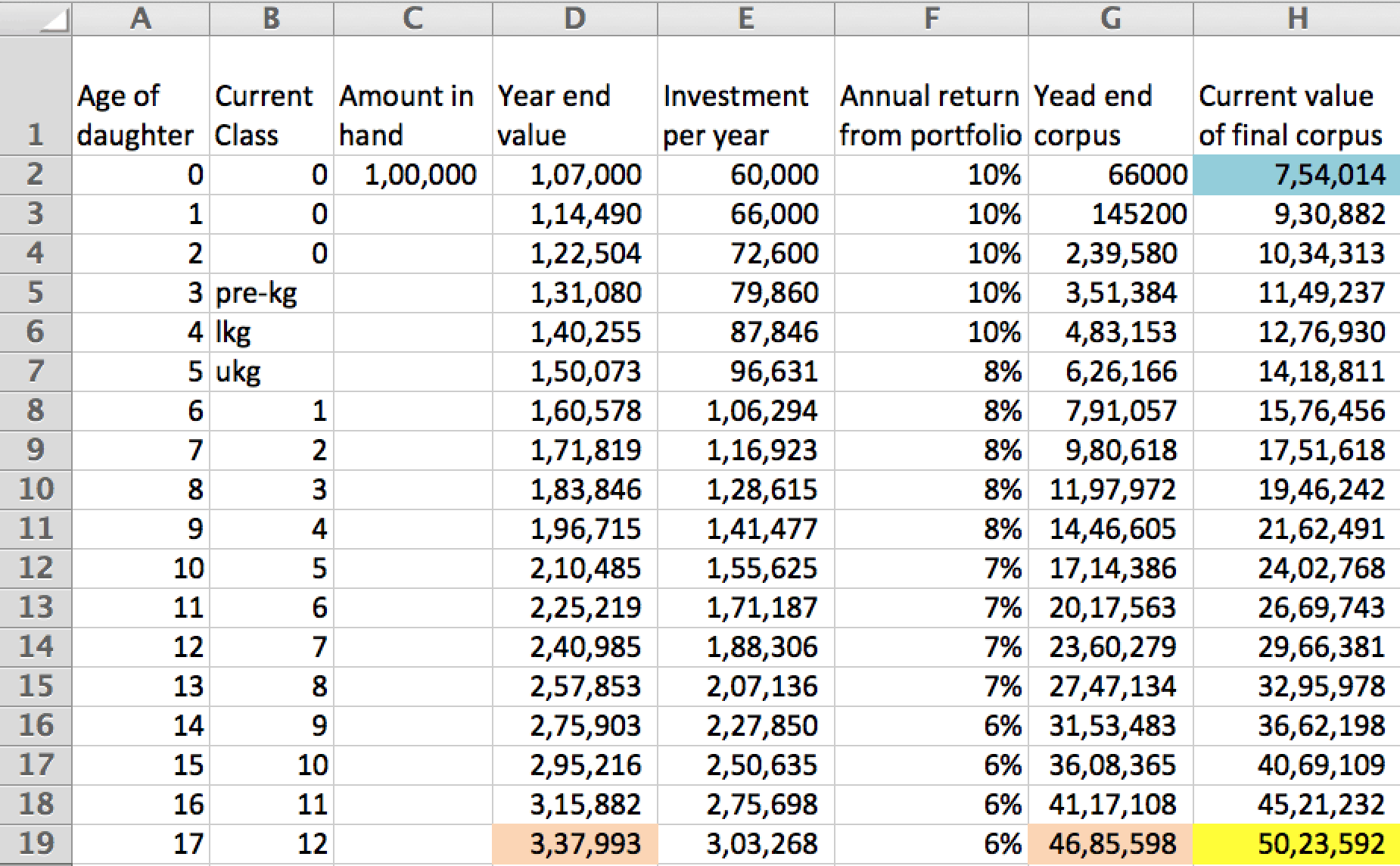Last Updated on May 28, 2022 at 6:43 pm
It is every parents’ dream and duty to ensure our children can do what they want to in life. It would also be great if our children do not start their earning lives with an educational loan Therefore it is important that we plan and invest right for our child’s future. Here is a simple calculation and a set of tips for this purpose. Please sit with your spouse this weekend and finish this task!
Readers may recall that I had done a similar exercise for retirement planning in two steps: Part one: Find out how much you need to retire in 15 mins: build your own calculator Video version is here(part 1). Part 2 video is here. One may ask which is more important? Planning for a secure retirement or our children’s future. Emotionally this is an easy question to answer: Our children come first!
Especially if we became young parents and can work for at least a decade after they start school. However since couples are becoming parents in their early and mid 30s with tough corporate jobs, both goals become equally important. Unless we sit and calculate how much investment is to be made, we will never take them seriously. That is why it is crucial to do this exercise as a couple.
Join 32,000+ readers and get free money management solutions delivered to your inbox! Subscribe to get posts via email! (Link takes you to our email sign-up form)
🔥Want to create a complete financial plan? Learn goal-based investing? Exclusive access to our DIY tools? Increase your income with your skills? Enjoy massive discounts on our robo-advisory tool & courses! 🔥
Step 1: Project current and current class (in school) into the future
Set up the following columns in any spreadsheet software of your choice. It will tel you when exactly you need the money for college. Or how many years you have to invest. Here it is 9 years
We also add the money available at hand, say Rs. one lakh in previous investments. We also assume you can invest Rs. 5000 a month or Rs. 60,000 a year. Here are assuming the girl will enter class four this coming academic year.
Step 2: Growth of the amount in hand
We assume that the Rs. One lakh in hand grows at about 7% post-tax a year, resuling in about 1.8 lakh after 9 years.
Step 3: Growth of future investment amount
This step is crucial. Please try to increase the investment amount by at least 10% a year!
Step 4: Computing the value of monthly investments
To do this, we first need to know how much to invest in equity and how to invest in fixed income. We need an asset allocation. Alternatively, we can enter a portfolio return each year as shown below.
This corresponds to about 40% equity initially and 60% fixed income for the first 3 years or so, reduced to 20% equity in the middle three years and 0% equity in the last three years. Where to invest this? I have made product suggestions in the video version linked below.
Step 5: finding the final investment amount
In column G, we compute how the investments made each year grows with the corresponding annual return in column F. In column H, the total final value is shown. The yellow cell is the sum of two orange cells. If you want some help in computing column G, see the vide version.
Step 6: Finding what the projected corpus is worth today
Now we take the value in the yellow cell and devalue it by 10% (assumed inflation in education expenses) year after year to find what the current value of the projected corpus is. To ensure I do it for 9 years, the cell in blue is devalued twice to get the current value.
So this means our future investments are worth about 5 lakh today. If this amount is at least 70-80% of a college education today, then the child will probably not need an educational loan.
Step 7: Choosing the investment products (watch video version)
The advantage of the above calculation is flexibility and a better understanding of what is going on and what has to be done.
Step 8: Projections for a newborn (<1-year-old) conservative
I have made two projections for a newborn with a full 17-18 years of time for investment. Even with a conservative return projection, the corpus is decent.
Step 9: Projections for a newborn (<1-year-old) aggressive
This is the same as above with with a more aggressive return expectation (higher equity)
Weekend exercise
- Please do these steps with your spouse and let me know if it was useful
- What kind of asset allocation would you use for step 8 and 9. Hint: How to reduce risk in an investment portfolio
Explore more videos from freefincal on YouTube
🔥Enjoy massive discounts on our courses, robo-advisory tool and exclusive investor circle! 🔥& join our community of 7000+ users!
Use our Robo-advisory Tool for a start-to-finish financial plan! ⇐ More than 2,500 investors and advisors use this!
Track your mutual funds and stock investments with this Google Sheet!
We also publish monthly equity mutual funds, debt and hybrid mutual funds, index funds and ETF screeners and momentum, low-volatility stock screeners.





- Do you have a comment about the above article? Reach out to us on Twitter: @freefincal or @pattufreefincal
- Have a question? Subscribe to our newsletter using the form below.
- Hit 'reply' to any email from us! We do not offer personalized investment advice. We can write a detailed article without mentioning your name if you have a generic question.
Join 32,000+ readers and get free money management solutions delivered to your inbox! Subscribe to get posts via email! (Link takes you to our email sign-up form)
About The Author
 Dr M. Pattabiraman(PhD) is the founder, managing editor and primary author of freefincal. He is an associate professor at the Indian Institute of Technology, Madras. He has over ten years of experience publishing news analysis, research and financial product development. Connect with him via Twitter(X), Linkedin, or YouTube. Pattabiraman has co-authored three print books: (1) You can be rich too with goal-based investing (CNBC TV18) for DIY investors. (2) Gamechanger for young earners. (3) Chinchu Gets a Superpower! for kids. He has also written seven other free e-books on various money management topics. He is a patron and co-founder of “Fee-only India,” an organisation promoting unbiased, commission-free investment advice.
Dr M. Pattabiraman(PhD) is the founder, managing editor and primary author of freefincal. He is an associate professor at the Indian Institute of Technology, Madras. He has over ten years of experience publishing news analysis, research and financial product development. Connect with him via Twitter(X), Linkedin, or YouTube. Pattabiraman has co-authored three print books: (1) You can be rich too with goal-based investing (CNBC TV18) for DIY investors. (2) Gamechanger for young earners. (3) Chinchu Gets a Superpower! for kids. He has also written seven other free e-books on various money management topics. He is a patron and co-founder of “Fee-only India,” an organisation promoting unbiased, commission-free investment advice.Our flagship course! Learn to manage your portfolio like a pro to achieve your goals regardless of market conditions! ⇐ More than 3,000 investors and advisors are part of our exclusive community! Get clarity on how to plan for your goals and achieve the necessary corpus no matter the market condition is!! Watch the first lecture for free! One-time payment! No recurring fees! Life-long access to videos! Reduce fear, uncertainty and doubt while investing! Learn how to plan for your goals before and after retirement with confidence.
Our new course! Increase your income by getting people to pay for your skills! ⇐ More than 700 salaried employees, entrepreneurs and financial advisors are part of our exclusive community! Learn how to get people to pay for your skills! Whether you are a professional or small business owner who wants more clients via online visibility or a salaried person wanting a side income or passive income, we will show you how to achieve this by showcasing your skills and building a community that trusts and pays you! (watch 1st lecture for free). One-time payment! No recurring fees! Life-long access to videos!
Our new book for kids: “Chinchu Gets a Superpower!” is now available!


Must-read book even for adults! This is something that every parent should teach their kids right from their young age. The importance of money management and decision making based on their wants and needs. Very nicely written in simple terms. - Arun.Buy the book: Chinchu gets a superpower for your child!
How to profit from content writing: Our new ebook is for those interested in getting side income via content writing. It is available at a 50% discount for Rs. 500 only!
Do you want to check if the market is overvalued or undervalued? Use our market valuation tool (it will work with any index!), or get the Tactical Buy/Sell timing tool!
We publish monthly mutual fund screeners and momentum, low-volatility stock screeners.
About freefincal & its content policy. Freefincal is a News Media Organization dedicated to providing original analysis, reports, reviews and insights on mutual funds, stocks, investing, retirement and personal finance developments. We do so without conflict of interest and bias. Follow us on Google News. Freefincal serves more than three million readers a year (5 million page views) with articles based only on factual information and detailed analysis by its authors. All statements made will be verified with credible and knowledgeable sources before publication. Freefincal does not publish paid articles, promotions, PR, satire or opinions without data. All opinions will be inferences backed by verifiable, reproducible evidence/data. Contact information: To get in touch, use this contact form. (Sponsored posts or paid collaborations will not be entertained.)
Connect with us on social media
- Twitter @freefincal
- Subscribe to our YouTube Videos
- Posts feed via Feedburner.
Our publications
You Can Be Rich Too with Goal-Based Investing
 Published by CNBC TV18, this book is meant to help you ask the right questions and seek the correct answers, and since it comes with nine online calculators, you can also create custom solutions for your lifestyle! Get it now.
Published by CNBC TV18, this book is meant to help you ask the right questions and seek the correct answers, and since it comes with nine online calculators, you can also create custom solutions for your lifestyle! Get it now.Gamechanger: Forget Startups, Join Corporate & Still Live the Rich Life You Want
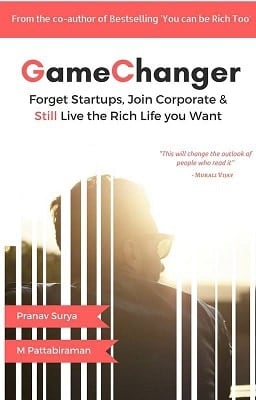 This book is meant for young earners to get their basics right from day one! It will also help you travel to exotic places at a low cost! Get it or gift it to a young earner.
This book is meant for young earners to get their basics right from day one! It will also help you travel to exotic places at a low cost! Get it or gift it to a young earner.Your Ultimate Guide to Travel
 This is an in-depth dive into vacation planning, finding cheap flights, budget accommodation, what to do when travelling, and how travelling slowly is better financially and psychologically, with links to the web pages and hand-holding at every step. Get the pdf for Rs 300 (instant download)
This is an in-depth dive into vacation planning, finding cheap flights, budget accommodation, what to do when travelling, and how travelling slowly is better financially and psychologically, with links to the web pages and hand-holding at every step. Get the pdf for Rs 300 (instant download)
